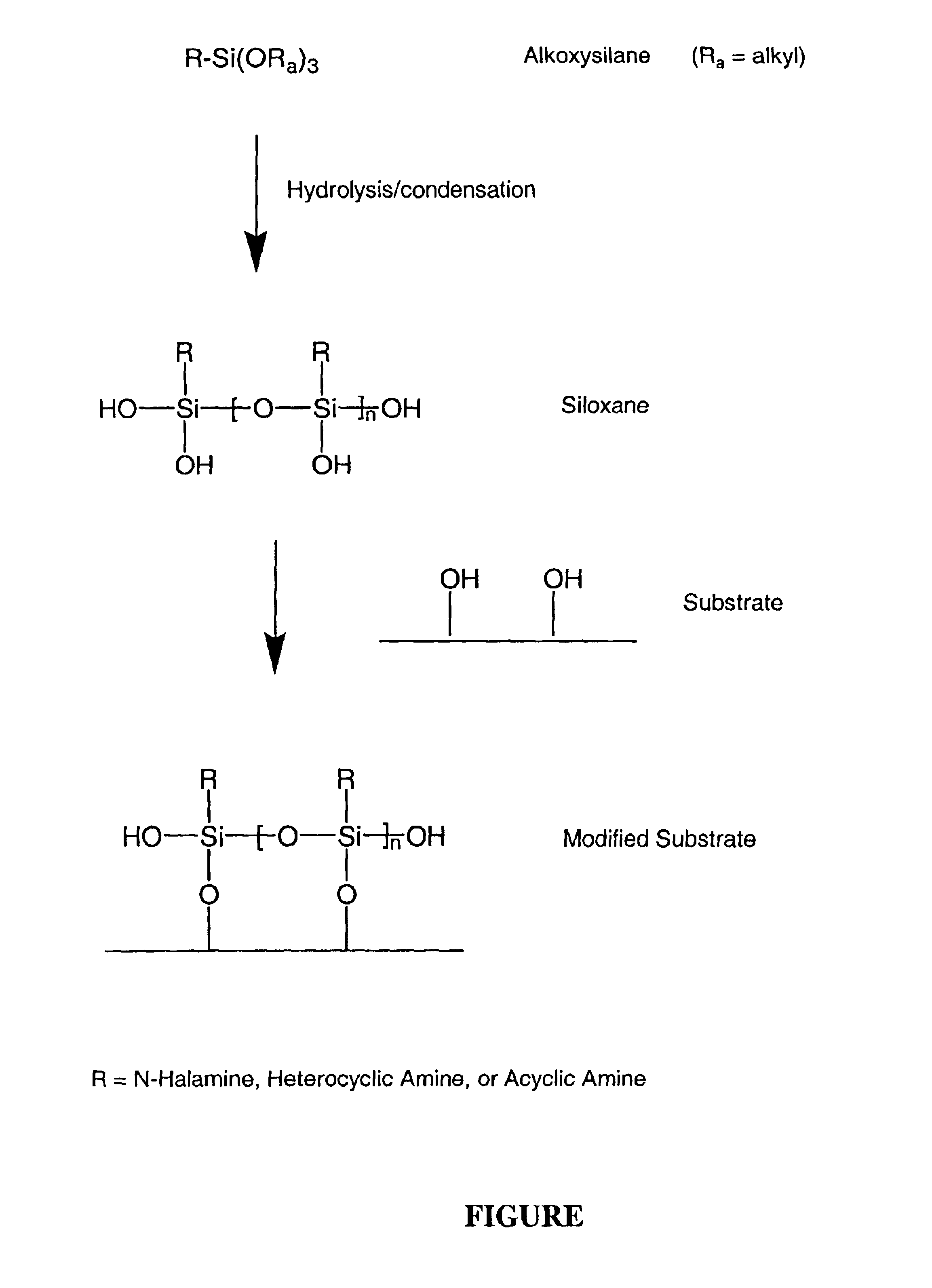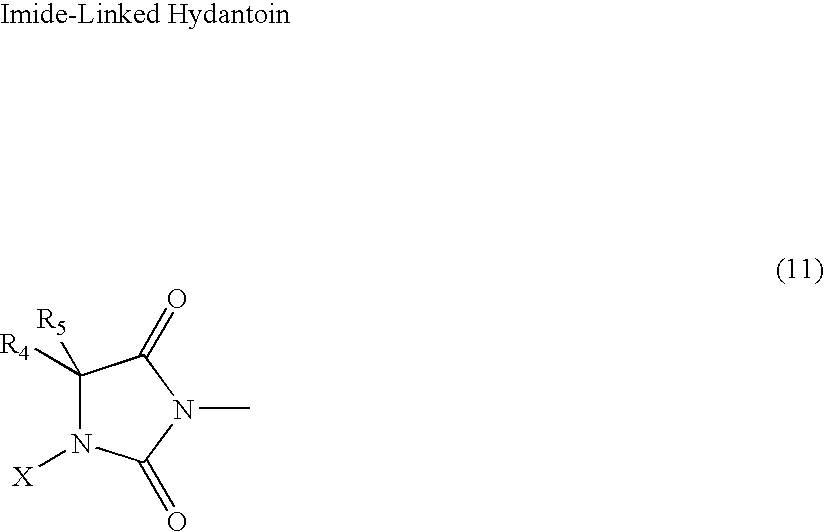N-halamine siloxanes for use in biocidal coatings and materials
a technology of n-halamine siloxanes and biocidal coatings, which is applied in the direction of group 3/13 element organic compounds, organic chemistry, transportation and packaging, etc., can solve the problems of non-regenerability of biocides and long contact times necessary for action, and achieve the effect of rendering surfaces and materials biocidal
- Summary
- Abstract
- Description
- Claims
- Application Information
AI Technical Summary
Benefits of technology
Problems solved by technology
Method used
Image
Examples
example 1
Preparation of a Representative Unhalogenated Silane Compound
[0072]Two trialkoxysilylpropylhydantoin derivatives were prepared according to a procedure similar to that outlined in U.S. Pat. No. 4,412,078.
[0073]A one-liter, three-neck-round-bottom flask was fit with a condenser, dropping funnel, and thermometer. To the flask was added a mixture of 500 mL of ethanol, 64.0 g (0.5 mol) of 5,5-dimethylhydantoin (Acros, Inc.), and 28.0 g (0.5 mol) of potassium hydroxide. The mixture was heated to the boiling point until the solution became clear. Then the solid potassium salt of the 5,5-dimethylhydantoin was isolated by evaporation of the ethanol solvent and the water produced in the reaction under reduced pressure. This salt was dried under vacuum at 60° C. for four days to form the anhydrous potassium salt. The dry salt was then placed back in the one liter flask where it was mixed with 500 mL of anhydrous N,N-dimethylformamide (DMF), and the mixture was heated at 60° C. until a clear s...
example 2
Preparation and Biocidal Efficacy of a Representative Chlorinated Silane Compound
[0075]A portion (6.11 g, 0.021 mol) of 3-trimethoxysilylpropylhydantoin, prepared as described in Example 1, was dissolved in 30 mL of methylene chloride in a 125 mL Erlenmeyer flask. Then 2.30 g (0.021 mol) of tert-butyl hypochlorite, prepared according to the method of Mintz, et al. (Org. Syn. 1969, 49:9-12), were added at room temperature, and the flask was stoppered, and the mixture was allowed to stand at room temperature for 3 hours with all light excluded. Vacuum evaporation was employed to remove the tert-butyl alcohol produced in the reaction. The product, 1-chloro-3-trimethoxysilylpropyl-5,5-dimethylhydantoin, was produced as a yellow oil in 89.7% yield. It was stored at 4° C. in the absence of light until use. The total chlorine content was determined to be 10.36% by iodometric / thiosulfate titration as compared to the theoretically possible value of 10.94%. The 1H NMR signal at δ 7.07 for 3-t...
example 3
Preparation of Biocidal Paper
[0077]Small pieces of white and brown commercial office envelopes were cut into small squares. A 2% aqueous alkaline solution (pH 3 from NaOH addition) of 3-triethoxysilylpropyl-5,5-dimethylhydantoin, prepared as described in Example 1, was sprayed from an atomizer bottle onto both sides of the paper samples until they became saturated. Then the wet samples were cured until dry at 60° C. for 15 minutes. The cured samples were then sprayed on both sides with 10% CLOROX bleach until saturated, allowed to stand at ambient temperature for 10 minutes, rinsed 5 times with 50 mL portions of chlorine-demand-free water, and dried at ambient temperature. The samples were stored in a vacuum desiccator until use for analytical and microbiological characterization.
[0078]An iodometric / thiosulfate titration procedure was used to determine the chlorine loadings on the squares of the two kinds of paper as a function of time after chlorination. The data are shown in Table...
PUM
| Property | Measurement | Unit |
|---|---|---|
| temperatures | aaaaa | aaaaa |
| temperatures | aaaaa | aaaaa |
| temperatures | aaaaa | aaaaa |
Abstract
Description
Claims
Application Information
 Login to View More
Login to View More - R&D
- Intellectual Property
- Life Sciences
- Materials
- Tech Scout
- Unparalleled Data Quality
- Higher Quality Content
- 60% Fewer Hallucinations
Browse by: Latest US Patents, China's latest patents, Technical Efficacy Thesaurus, Application Domain, Technology Topic, Popular Technical Reports.
© 2025 PatSnap. All rights reserved.Legal|Privacy policy|Modern Slavery Act Transparency Statement|Sitemap|About US| Contact US: help@patsnap.com



